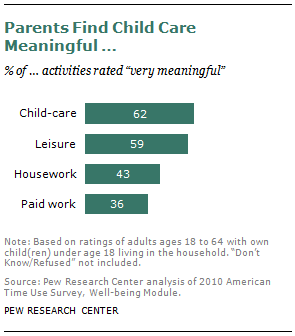
There’s no tougher job than being a parent, or so the saying goes. This sentiment seems to be confirmed by a new Pew Research Center analysis of government time use data. Parents find caring for their children to be much more exhausting than the work they do for pay. At the same time, parents find much more meaning in the time they spend with their children than in the time they spend at work.
American parents with children under age 18 find 62% of their child-care experiences “very meaningful,” compared with 36% of paid work-related activities. They also rate 12% of child-care activities “very tiring,” compared with 5% of paid work-related activities.
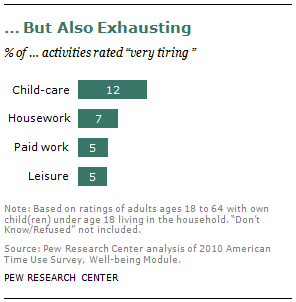
These findings are based on an analysis of the new Well-being Module from the American Time Use Survey (ATUS). Launched by the Bureau of Labor Statistics (BLS) in 2003, the ATUS provides nationally representative estimates of how Americans spend their time. In addition to standard time use questions, the 2010 ATUS included new measures to gauge respondents’ emotional state during various activities. For example, did they feel happy, stressed or tired? How meaningful did they find various activities?
When it comes to feeling happy, time with children also beats time at work. Parents on average report that they are “very happy” in 35% of their child-care activities, compared with 19% of their paid work-related activities. In fact, the happiness level that parents experience during their time caring for children is only slightly lower than it is during their leisure time (41% rated as very happy).
Parents feel somewhat less stressed during their time with children than their time at work. Some 3% of child-care activities are rated as “very stressful,” compared with 5% of paid work activities. Instead, parents feel that they are “not stressed at all” in about half of their child-care activities (52%), compared with 20% of paid work-related activities.
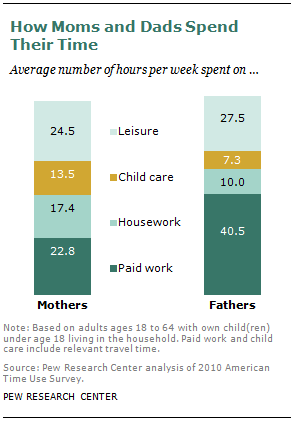
Important gender differences underlie these overall patterns, and the gender differences seem to hold up when the employment status of parents is taken into consideration.1 While mothers and fathers are equally likely to find meaning in the time they spend with their children and in the workplace, when it comes to housework and leisure activities, mothers are more likely than fathers to feel what they do is very meaningful. At the same time, mothers feel more exhausted than fathers in all four of these realms.
Overall, fathers spend significantly more hours each week in paid work than do mothers (40 hours vs. 23 hours, on average), while mothers’ time in unpaid work (child care and housework) is much longer than that of fathers (31 hours per week vs. 17 hours). Fathers have three hours per week more leisure time than mothers do.
When looking at the specific activities that parents engage in, the analyses also suggest that fathers and mothers allocate their time quite differently during similar types of activities. Fathers spend significantly less time than mothers in almost all child-care activities except for playing with children, where the gap is the smallest. Fathers and mothers on average both spend about two hours per week in recreational-type child-care activities.
In the area of housework, fathers spend more time doing household repairs and maintenance (such as vehicles and lawn care) than do mothers (four hours per week vs. one hour), but mothers do much more cooking and cleaning than do fathers (a combined total of 15 hours per week vs. five hours per week).
How Parents Feel about the Way They Spend their Time
Child care is rated as one of the most meaningful activities by parents.2 Parents with children under age 18 find 62% of their child-care experiences “very meaningful,” compared with 43% of housework and 36% of paid work-related activities.
Meanwhile, when asked about their level of tiredness, child care registers as the most exhausting activity for parents. About 12% of child-care activities get a rating of “very tiring,” compared with 7% of housework activities, and 5% of both leisure and paid work-related activities.3
The survey method employed in the American Time Use Survey is often referred to as a “time diary,” as it walks respondents through their previous day (24 hours), records all the activities they did sequentially and how much time they spent in each activity.4 Activities are classified into 17 major time-use categories and more than 400 detailed sub-categories or episodes. For the purpose of this study, we extracted the time that respondents spent in four major areas: paid work, housework, child care and leisure. The ATUS data files were downloaded from ATUS-X (www.atusdata.org).5 A list of detailed activities in each area can be found in Appendix 3.
In addition to standard time use questions, the 2010 ATUS included new measures to gauge respondents’ emotional state during various activities. After respondents completed a 24-hour diary, they were asked on a scale of 0 to 6 (where 0 means the respondent did not experience the feeling at all, and 6 means the feeling was very strong), about how they felt during the time they engaged in three randomly selected activities.6 This report analyzes the data at the activity level, and each activity is associated with a rating of feelings by respondents (happy, stressed, tired, and meaningful).
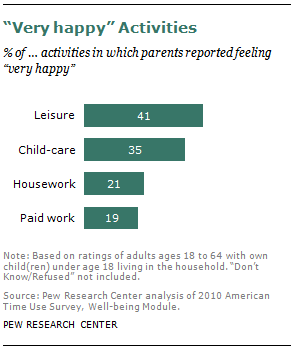
When it comes to feeling happy, time with children ranks high, although not the highest, among the four areas of parents’ time use. Parents feel “very happy” in 35% of their child-care activities and 41% of their leisure activities. Yet taking care of children is much more pleasant than doing housework or paid work: Parents feel very happy during their time in 21% of housework activities and 19% of their work-related activities.
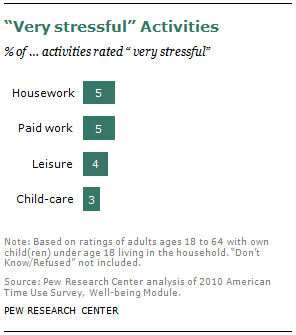
Compared with other daily activities, parents do not seem to experience particularly high levels of stress during the time they are taking care of their children. Only 3% of child-care activities are rated as “very stressful,” compared with 4% of leisure activities, and 5% of work-related activities (housework and paid work). Instead, parents report that they are “not stressed at all” in 52% of child-care activities, compared with 20% of paid work and 37% of housework.
Gender Differences in Feelings
Mothers are more likely than fathers to feel that what they are doing is highly meaningful when they are taking care of the house or engaging in leisure activities. Mothers and fathers are about equally likely to find meaning in caring for children as well as in paid work. However, mothers feel more tired than fathers in all four activities.
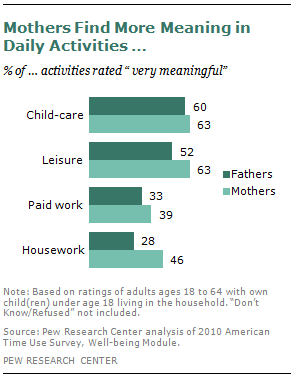
Mothers rate 46% of their housework activities as “very meaningful,” while fathers do the same for 28% of their housework activities. Likewise, mothers rate 63% of their leisure time as highly meaningful. Fathers are somewhat less likely to find meaning in their leisure activities (52% highly meaningful).
Mothers and fathers are about equally likely to find meaning in caring for children: 63% of child-care activities are “very meaningful” to mothers, and so are 60% of child-care experiences to fathers.
Paid work has similar meaning to fathers and mothers as well. Mothers who have spent time in paid work find 39% of what they do at a job very meaningful, and fathers feel the same way about 33% of their paid work activities (the difference is not statistically significant).
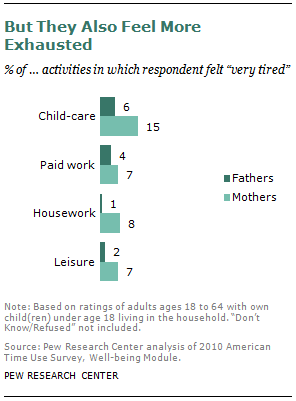
Mothers find all of these activities more exhausting than do fathers, and the largest gap is in child-care time. Mothers report feeling “very tired” in 15% of child-care activities, and fathers feel this way in 6% of their child-care activities. Mothers also report a higher level of fatigue than fathers did in paid work, housework and leisure time.
These findings are in line with previous research on gender and feeling tired. According to recent data from Centers for Disease Control and Prevention (CDC), women often feel more exhausted than men. During 2010-2011, some 15% of women reported that they felt “very tired or exhausted” every day or on most days, compared with 10% of men.7
Mothers also feel a higher level of happiness than fathers when taking care of children. Some 37% of mothers’ child-care activities were “very happy” moments, compared with about 29% of fathers’ child-care activities.
Gender Differences in Time Use Patterns
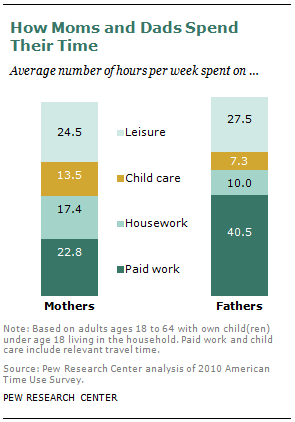
Not only do mothers and fathers feel differently when they engage in the same activities, but they also spend their time differently. The amount of time fathers spend on housework and child care has increased significantly in the past half century. Even so, the time mothers spend on housework and child care is still about twice that of fathers. Meanwhile, mothers spend significantly less time in paid work than do fathers.
In 2010, the same year that the well-being module of the ATUS was conducted, fathers with children younger than 18 spent, on average, about 41 hours per week in paid work,8 which occupied the biggest share of their non-sleeping hours. Fathers also spent about 28 hours per week in leisure-related activities such as TV and sports, 10 hours doing household chores and seven hours in child-care activities.
Mothers’ time allocation is more evenly spread out than that of fathers. On a weekly basis, mothers on average spend 23 hours in paid work outside the home, about 24 hours in leisure-related activities, 17 hours in housework and 14 hours in child care.
These time use patterns for fathers and mothers have been fairly consistent since ATUS started collecting data in 2003.
The different feelings fathers and mothers have about the way they spend their time may be related to the specific activities in which they’re engaged. For example, taking care of children includes a range of activities from bathing, to helping with homework, or playing. Parents may experience different emotions during each of these activities. Detailed activity categories provide a fuller picture of how fathers and mothers may differ in their time use, even when they are engaged in the same type of activities.
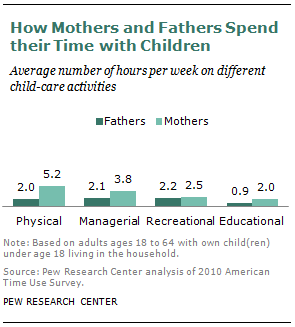
To illustrate this, we divided child-care time into four detailed activities: physical, managerial, recreational and educational.9 Physical care includes activities such as changing diapers, feeding and dressing a child, and care related to children’s health. Recreational care includes activities such as playing games or sports with children. Educational activities include reading and helping with homework. And managerial activities related to child care include organizing and planning for children, attending events and the like.
Similarly, we divided the household tasks into four categories: cleaning, cooking, repair and management. For leisure activities, we included TV and other media use (including listening to radio, computer games), social leisure time (parties, events) and leisure sports activities.10
Looking at child-care time at a more detailed level, mothers spend more time than fathers in all four tasks related to child care. The biggest gender gap in child-care time is in physical care: Mothers spend 5.2 hours per week tending to children’s physical needs, about 2.6 times as much as what fathers spend in these activities (two hours per week). Mothers’ child-care time in managerial and educational activities is about twice that of fathers.
When it comes to playing with children, the gap is relatively small. Fathers on average spend about 2.2 hours per week in recreational type of child-care activities, compared with 2.5 hours for mothers.
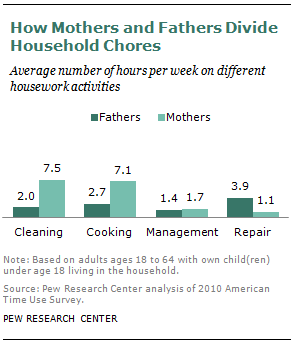
Fathers and mothers are a bit specialized in household tasks, even though mothers are still doing more overall. On average, mothers spend about seven hours per week doing cleaning and laundry, more than three times as much as what fathers spend on these tasks (two hours per week). On the other hand, fathers spend about four hours per week doing household repairs and maintenance (such as vehicles and lawn care), while mothers spend about one hour per week in these activities.
Mothers also do a lot more cooking than fathers. On a weekly basis, mothers spend about seven hours cooking meals (and cleaning the kitchen), and the time that fathers spend on these tasks is about three hours per week.
When it comes to household management, the gender gap is not as big. The amount of time that mothers spend in managing the household is 1.7 hours per week, slightly higher than the 1.4 hours per week time fathers spend on this. Household management is a broad category; it includes financial management, organization and planning as well as activities, such as care for pets, that cannot be categorized in other household tasks.
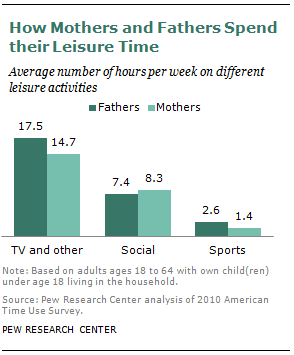
Mothers and fathers are also somewhat different in terms of the type of leisure activities in which they engage. Fathers tend to spend more time watching TV or playing sports than mothers do, while mothers engage in more social activities.
Fathers spend about 17 hours per week watching TV or using other media for leisure, compared with about 15 hours for mothers. Fathers also spend about twice as much time playing sports as mothers do (2.6 hours per week vs. 1.4).
Mothers spend about one more hour a week in social leisure activities than do fathers (8.3 hours per week vs.7.4). The social activities are broad. They often involve more interaction with others, such as attending or hosting parties or events. But a few activities that can’t be categorized in other leisure types, such as hobbies, are also included.




